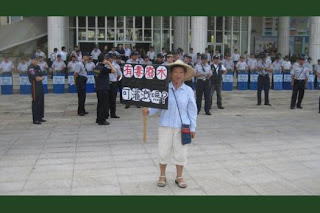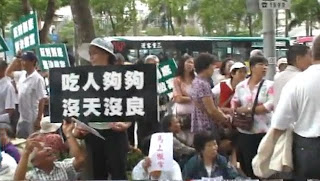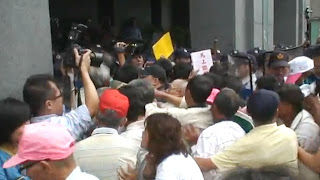Two stories from today’s local Hanji [1] press indicate that Taiwan continues to practice “Cat in the Hat” economics. The first was “Premier Wu Dun-yi: Three Major Investment Projects Will Spur Employment” in which we were told about the Executive Yuan support for the Fourth Stage of the Central Science Park Erlin, the Guoguang Petrochemical project and the Fifth Stage of the Sixth Naphtha Plant of Formosa Plastics. The investments will be more than a million million NT$ and will bring twenty to thirty thousand jobs. The second was about how the first of those projects, the Central Science Park project a Erlin would overcome all obstacles to achieve its purpose, the main obstacle, according to the article, being the disposal of waste water. If they can’t give it to the Guo Guang Petrochemical Park to use, then they will pipe it three kilometers out into ETS
Sousa habitat.
I thought Cat in the Hat Economics might be an original idea with me, maybe it is, but someone beat me to it with a blogger talking about the metaphor in the context of the banking bail out[2].
Most of us should remember the story of the Cat in the Hat. The kid (Wall Street and the banking industry) makes a mess and creates a stain and the Cat in the Hat (The US Government) tries one thing after another but can get rid of the problem. The cat simply transfers the stain from one article to another actually making it far worse in the process. Morale of the story: One can't run from or hide from problems to deal with them.
Actually, we are going further than this. The Chinese KMT Ma regime is actually continuing on its merry path, deceiving the Taiwanese into thinking nothing has really changed in the world, there is no climate destabilization, or if there is, it has nothing to do with us and government policies to encourage toxic high waste, high consumption industries are fine, because amidst the social, economic and natural environmental havoc it is laying on Taiwan, there is a magic bullet at the end – something that will “clean it all up” as that little last cat did just in time. The magic pill changes from day to day, sometimes it is China and ECFA, sometimes it is new investments. But the mess keeps growing and along with the human cost in terms of health, social justice and economic security, we are taking down many, many other species with us. So there really is little point in all of this talk about a green economy, because there is no way we are going to catch up with the destructive practices of government, industry, academia and our elected officials. Friday is the show-down on Erlin at the EPA’s EIA plenary meeting.
English translation of the two articlesWu Dun-yi:
Three Major Investment Projects Will Spur EmploymentEconomic Daily News Reported by Wu Bi-eh, Ciu Sin-yi in Taipei and Tainan
25 October 2009
Executive Yuan Premier Wu Dun-yi yesterday (24 October 2009) pointed out that stimulating jobs and cutting the unemployment rate are the governments most important policies at this time so that the Executive Yuan will promote the Fourth Stage of the Central Science Park, the Guoguang Petrochemical project and the Fifth Stage of the Sixth Naphtha Plant of Formosa Plastics. The investments will be more than a million million NT$ and will bring twenty to thirty thousand employment opportunities.
At a jobs fair in Tainan yesterday, while attending the activities, Wu Dun-yi emphasized the governments resolve in promoting large scale investment projects; he pointed out the government’s absolute duty to provide an environment in which people can be assured of jobs and stimulate employment and this has also been the policy of objective since he took office.
The Directorate General of Budget Accounting and Statistics announce that the September unemployment rate, although down a bit, was still more than 6%; Wu Dun-yi pointed out that while stimulating short term employment opportunities would have some positive impact on the unemployment rate, the most fundamental way was to create long term stable job opportunities.
Jennifer Wang, Minster of Labor said the “immediate get to work plan” starting from October last year through 21 October this year, was to deal with the fallout from the financial crisis and statistics showed that just in the counties of Yunlin, Chiayi and Tainan the service center had already helped 6,710 people get jobs.
In addition, the government has also begun a special program to develop diverse employment opportunities, helping to find employment for middle and elderly people who have lost their jobs as well as disadvantaged groups.
To stimulate jobs the Council for Labor Affairs starting from 22 October will hold a series of seven large scale job fairs altogether providing twenty thousand jobs; at the fair in Tainan yesterday one hundred businesses were looking for over 3000 applicants to fill positions, including leading companies such as 奇美電、晶電、茂迪、益通 whose orders have been recovering business developments otherwise call for more jobs. In total the number of attendees yesterday were 6,596 with 7,780 applications being filed and preliminary successes in matching job seekers with employment opportunities were at 1,514 or a success rate of 26.3 percent.
According to 104 Labor Bank, the demand for personnel has rebounded and for the past ten months has been increasing, with 243,000 positions open in October. With the economic recovery the unemployment rate has peaked and there is a falling trend which bodes well for the jobless situation.
Central Science Park Fourth Stage – Barging the Gates of Environmental Impact AssessmentEconomic Daily News Reported by Sung Jian-sheng from Taichung
25 October 2009
The Environmental Protection Administration has set Friday (30 October 2009) to have a meeting of the plenary session of the Environmental Impact Assessment Commission on the fourth stage of the Central Science Park in Erlin, which if the EIA goes smoothly, Yang Wun-ke, the head of the CSP Bureau, says ground breaking can begin as early as before the end of the year and it could be completed within five years.
Yang Wun-ke emphasized that AUO has planned an investment in the park amounting to NT$4,000,000,000,000 to build the largest optical fibre plants in the county to start up by the third quarter next year, so looking at the status of the EIA, if the case goes through in the plenary there should be no adverse impact on the progress of AUO’s investment.
There are already over ten companies that are interested in investment in the Erlin Central Science Park, and in addition to AUO, Winbond, Chunghwa Picture Tube, Hota, Syudong (?), the French company Air Liquide, Dipao (?), Kefong (?), Helius Power Corporation total investments will be over NT$6,000,000,000,000.
To ensure that the Erlin Park does not end up still born, Premier Wu Dun-yi has already indicated that if the waste water from Erlin can be used for the Guoguang Petrochemical Plant’s use then the connecting pipeline will be laid. If Guoguang Petrochemical, can’t use the water then it will be discharged into the ocean three kilometers from the low tide line, after passing through a pipeline that will be three kilometers so as to ensure that the people of Yunlin and Changhua can rest assured.
Yang Wun-ke said that the EIA subcommittee passed the case with conditions and the Central Science Park Administration will do its best to oblige, in the future the discharge pipeline will be extended from 14 kilometers to 35 kilometers and the total investment increased from 3.3 billion NT$ to 6.87 billion, such additional funds to come out of the Science Park Operating Fund.
In the midst of the voices of protest the EIA subcommittee passed the continuation of the case conditionally.
Currently the largest investor in Central Science Park case is AUO which plans an optoelectronics village with NT$4,000,000,000,000 which will be used to build fourth generation 10 inch wafer fab and this will also attract downstream related businesses, and as the chip industry has seen recovery, AUO’s two 8.5 inch wafer fabs in the Central Science Park in Houli have also restarted operations.
吳敦義:三大投資 促進就業
【經濟日報╱記者吳碧娥、邱馨儀╱台北、台南報導】2009.10.25 04:18 am
行政院長吳敦義昨(24)日指出,促進就業與降低失業率是政府當前最重要的政策,行政院將推動中科四期、國光石化與台塑六輕五期等三個大型投資計畫,投資總額逾兆元,將可帶動二、三萬個就業機會。
勞委會昨天在台南舉辦就業博覽會,吳敦義在出席活動時強調政府推動重大投資計畫的決心;他指出,為民眾提供安心的勞動環境、促進就業,是政府責無旁貸的事,也是他上任後的施政目標。
主計處最近公布9月失業率,雖然小幅下跌,但仍突破6%;吳敦義指出,促進短期就業對改善失業率雖有一定效果,但最根本的,還是要創造長期穩定的工作機會。
勞委會主委王如玄表示,「立即上工計畫」是為因應金融海嘯自去年10月推動,截至今年10月21日,統計僅雲嘉南區就業服務中心即已協助6,710人就業。
此外,政府也開辦多元就業開發專案,幫助中高年齡失業、弱勢族群就業。
為促進就業,勞委會從22日起陸續辦理七場大型就業博覽會,共釋出2萬多個工作機會;昨天在台南縣舉辦的就業博覽會,有100多家廠家提供3,000多個職缺,包括奇美電、晶電、茂迪、益通等指標企業,都因訂單回流或產業發展傳出利多釋出大量職缺,統計昨天共湧入6,596人,投遞履歷7,780人次,初步媒合1,514人,媒合率達二成六三。
根據104人力銀行統計,人力需求持續回升,工作職缺數已連十個月成長,10月時已達到24.3萬個職缺。隨景氣逐步復甦,失業率有探頂下滑趨勢,接下來循環性失業狀況可望好轉。
【2009/10/25 經濟日報】
中科四期環評 再闖關
【經濟日報╱記者宋健生/台中報導】2009.10.25 04:18 am
環保署訂本周五(30日)召開中科四期二林園區基地環評大會,中科管理局長楊文科表示,環評若順利過關,二林園區最快今年底前動工,預計五年內完工。
楊文科強調,友達將在二林園區投資4,000億元,建構我國最大的光電產業聚落,預計明年第三季啟動,以目前二林園區環評進度來看,只要環評大會順利通過,應不致影響友達的投資與建廠進度。
中科二林園區已有十幾家廠商表達投資意願,除了友達,還有華邦、華映、和大、旭東、法商液空、帝寶、科風、東君能源系統等,累計投資金額已逾6,000億元。
為力保二林園區開發不會胎死腹中,行政院長吳敦義已指示,中科四期排放水若可供國光石化運用,則可用接管方式送達。若國光石化不用,放流點可經由低潮線起算,加長3公里的排放管,排放至海域,務必做到讓雲林及彰化兩縣民眾都能放心。
楊文科說,環評審查小組的附帶條件,中科管理局會全力支持配合,未來二林園區廢水排放管線長度,將由原規劃的14公里延長為35公里,總經費由33億元增至68.7億元,新增經費由科學園區作業基金中借貸支應。
在民眾抗議聲中,環評專案小組延續會議日前有條件通過中科二林園區的環評審查。
專案小組要求,二林基地在初期與中期階段,必須完成海岸排放專管才能營運,每日廢水排放量必須在7萬噸以下,環評委員還要求,廢水須排放在濁水溪或是舊濁水溪河口潮間帶的低潮線以下。
中科二林園區原訂今年7月底動工,但因環評審查受阻,工程延誤近半年,投資廠商焦慮不已。楊文科說,環評審查初步過關,大家都鬆了一口氣,希望環評大會能夠順利通過此案。
中科二林園區目前最大的投資案,是友達計畫建構的光電產業聚落,總投資金額達4,000億元,將規劃興建四座十代以上大尺寸面板廠,並引進上中下游產業關聯廠商。隨面板產業景氣復甦,友達中科后里園區的第二座8.5代廠已經復工。
【2009/10/25 經濟日報】
Click
here to sign the petion against the CTSP Erlin Science Park project.
Also see:
Leave Taiwan's future a clean Chuoshui River Stop the CTSP Erlin Science Park; Protect Farmers, Fishermen and the Taiwan Humpback Dolphins. Update: Stop the CTSP Erlin Science Park - Protect Farmers, Fishers and the Taiwan Humpback Dolphins. Black Friday for Erlin - The EPA once again strikes a blow against the environmentThe saga of the CTSP Erlin Science Park and the Kuokuang Petrochemical ProjectAll three effluent discharge proposals for Central Taiwan Science Park development will lead to pollution of humpback dolphin habitat More protests at the EPA against the CTSP Erlin Science ParkTaiwan's Humpback Dolphins face extinction






